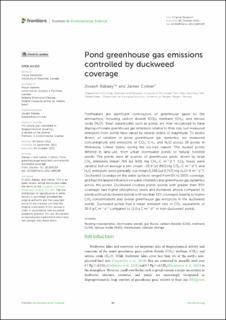| dc.contributor.author | Rabaey, Joseph | |
| dc.contributor.author | Cotner, James | |
| dc.date.accessioned | 2023-01-04T10:45:41Z | |
| dc.date.available | 2023-01-04T10:45:41Z | |
| dc.date.created | 2022-11-03T15:11:20Z | |
| dc.date.issued | 2022-10-05 | |
| dc.identifier.issn | 2296-665X | |
| dc.identifier.uri | https://hdl.handle.net/11250/3040871 | |
| dc.description.abstract | Freshwaters are significant contributors of greenhouse gases to the atmosphere, including carbon dioxide (CO2), methane (CH4), and nitrous oxide (N2O). Small waterbodies such as ponds are now recognized to have disproportionate greenhouse gas emissions relative to their size, but measured emissions from ponds have varied by several orders of magnitude. To assess drivers of variation in pond greenhouse gas dynamics, we measured concentrations and emissions of CO2, CH4, and N2O across 26 ponds in Minnesota, United States, during the ice-free season. The studied ponds differed in land-use, from urban stormwater ponds to natural forested ponds. The ponds were all sources of greenhouse gases, driven by large CH4 emissions (mean 704 [sd 840] mg CH4-C m−2 d−1). CO2 fluxes were variable, but on average a sink (mean −25.9 [sd 862] mg CO2-C m−2 d−1), and N2O emissions were generally low (mean 0.398 [sd 0.747] mg N2O-N m−2 d−1). Duckweed coverage on the water surfaces ranged from 0% to 100% coverage, and had the largest influence on water chemistry and greenhouse gas dynamics across the ponds. Duckweed covered ponds (ponds with greater than 85% coverage) had higher phosphorus levels and increased anoxia compared to ponds without duckweed (ponds with less than 12% coverage), leading to higher CH4 concentrations and overall greenhouse gas emissions in the duckweed ponds. Duckweed ponds had a mean emission rate in CO2 equivalents of 30.9 g C m−2 d−1 compared to 11.0 g C m−2 d−1 in non-duckweed ponds. | en_US |
| dc.language.iso | eng | en_US |
| dc.publisher | Frontiers | en_US |
| dc.rights | Navngivelse 4.0 Internasjonal | * |
| dc.rights.uri | http://creativecommons.org/licenses/by/4.0/deed.no | * |
| dc.title | Pond greenhouse gas emissions controlled by duckweed coverage | en_US |
| dc.type | Journal article | en_US |
| dc.type | Peer reviewed | en_US |
| dc.description.version | publishedVersion | en_US |
| dc.rights.holder | Copyright 2022 the authors | en_US |
| dc.source.articlenumber | 889289 | en_US |
| cristin.ispublished | true | |
| cristin.fulltext | original | |
| cristin.qualitycode | 1 | |
| dc.identifier.doi | 10.3389/fenvs.2022.889289 | |
| dc.identifier.cristin | 2068775 | |
| dc.source.journal | Frontiers in Environmental Science | en_US |
| dc.identifier.citation | Frontiers in Environmental Science. 2022, 10, 889289. | en_US |
| dc.source.volume | 10 | en_US |

